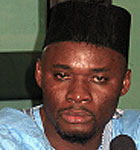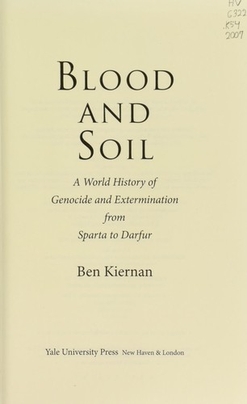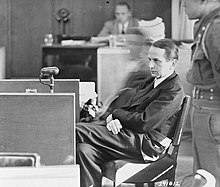
Genocide is the intentional destruction of a people in whole or in part.

Genocide denial is the attempt to deny or minimize the scale and severity of an instance of genocide. Denial is an integral part of genocide and includes the secret planning of genocide, propaganda while the genocide is going on, and destruction of evidence of mass killings. According to genocide researcher Gregory Stanton, denial "is among the surest indicators of further genocidal massacres".
The Convention on the Prevention and Punishment of the Crime of Genocide (CPPCG), or the Genocide Convention, is an international treaty that criminalizes genocide and obligates state parties to pursue the enforcement of its prohibition. It was the first legal instrument to codify genocide as a crime, and the first human rights treaty unanimously adopted by the United Nations General Assembly, on 9 December 1948, during the third session of the United Nations General Assembly. The Convention entered into force on 12 January 1951 and has 152 state parties as of 2022.

Radio Télévision Libre des Mille Collines (RTLM) was a Rwandan radio station which broadcast from July 8, 1993, to July 31, 1994. It played a significant role in inciting the Rwandan genocide that took place from April to July 1994, and has been described by some scholars as having been a de facto arm of the Hutu government.

Hassan Ngeze is a Rwandan journalist and convicted war criminal best known for spreading anti-Tutsi propaganda and Hutu superiority through his newspaper, Kangura, which he founded in 1990. Ngeze was a founding member and leadership figure in the Coalition for the Defence of the Republic (CDR), a Rwandan Hutu Power political party that is known for helping to incite the genocide.

Kangura was a Kinyarwanda and French-language magazine in Rwanda that served to stoke ethnic hatred in the run-up to the Rwandan genocide. The magazine was established in 1990, following the invasion of the rebel Rwandan Patriotic Front (RPF), and continued publishing up to the genocide. Edited by Hassan Ngeze, the magazine was a response to the RPF-sponsored Kanguka, adopting a similar informal style. "Kangura" was a Rwandan word meaning "wake others up", as opposed to "Kanguka", which meant "wake up". The journal was based in Gisenyi.

Armenian genocide denial is the claim that the Ottoman Empire and its ruling party, the Committee of Union and Progress (CUP), did not commit genocide against its Armenian citizens during World War I—a crime documented in a large body of evidence and affirmed by the vast majority of scholars. The perpetrators denied the genocide as they carried it out, claiming that Armenians in the Ottoman Empire were resettled for military reasons, not exterminated. In the genocide's aftermath, incriminating documents were systematically destroyed, and denial has been the policy of every government of the Republic of Turkey, as of 2023, and later adopted by the Republic of Azerbaijan, as of 1991.
The "Hutu Ten Commandments" was a document published in the December 1990 edition of Kangura, an anti-Tutsi, Hutu Power Kinyarwanda-language newspaper in Kigali, Rwanda. The Hutu Ten Commandments are often cited as a prime example of anti-Tutsi propaganda that was promoted by genociders in Rwanda following the 1990 invasion by the Rwandan Patriotic Front and prior to the 1994 Rwandan genocide. The chief editor of Kangura, Hassan Ngeze, was convicted of genocide and crimes against humanity in 2003 by the International Criminal Tribunal for Rwanda and was sentenced to 35 years' imprisonment.

Génocidaires are Rwandans who are guilty of genocide due to their involvement in the mass killings which were perpetrated in Rwanda during the 1994 genocide against the Tutsi, in which 800,000 Rwandans, primarily Tutsis and moderate Hutu, were murdered by the Interahamwe. In the aftermath of the genocide, Rwandans who organized and led the genocide were put on trial at the International Criminal Tribunal for Rwanda. Those guilty of lesser crimes, such as participation, profiting through seizing Tutsi property, and the like, were put on trial in gacaca courts. Today, the ICTR has indicted over ninety-three people for genocide. In 2020, Félicien Kabuga, the main financier of the Rwandan Genocide, was found in suburban France after evading capture for over twenty-six years.

Blood and Soil: A World History of Genocide and Extermination from Sparta to Darfur (ISBN 978-0300100983) is a 2007 book by Ben Kiernan, who for thirty years has studied genocide and crimes against humanity. In Blood and Soil, Kiernan examines outbreaks of mass violence, including worldwide colonial exterminations and twentieth-century case studies, particularly the Armenian genocide, the Nazi Holocaust, Stalin's mass murders, and the Cambodian and Rwandan genocides. The book won the 2008 gold medal for the best book in History awarded by the Independent Publishers Association. In 2009, Blood and Soil won the German Studies Association's biennial Sybil Halpern Milton Memorial Book Prize for the best book published in 2007 or 2008 dealing with Nazi Germany and the Holocaust in its broadest context, covering the fields of history, political science, and other social sciences, literature, art, and photography. In June 2009, the book's German translation, Erde und Blut: Völkermord und Vernichtung von der Antike bis heute, won first place in Germany's Nonfiction Book of the Month Prize.
Rwandan genocide denial is the pseudohistorical assertion that the Rwandan genocide did not occur, specifically rejection of the scholarly consensus that Rwandan Tutsis were the victims of genocide between 7 April and 15 July 1994. The perpetrators, a small minority of other Hutu, and a fringe of Western writers dispute that reality.
During the Rwandan genocide of 1994, over the course of 100 days, up to half a million women and children were raped, sexually mutilated, or murdered. The International Criminal Tribunal for Rwanda (ICTR) handed down the first conviction for the use of rape as a weapon of war during the civil conflict, and, because the intent of the mass violence against Rwandan women and children was to destroy, in whole or in part, a particular ethnic group, it was the first time that mass rape during wartime was found to be an act of genocidal rape.

Incitement to genocide is a crime under international law which prohibits inciting (encouraging) the commission of genocide. An extreme form of hate speech, incitement to genocide is an inchoate offense and is theoretically subject to prosecution even if genocide does not occur, although charges have never been brought in an international court without mass violence having occurred. "Direct and public incitement to commit genocide" was forbidden by the Genocide Convention in 1948. Incitement to genocide is often cloaked in metaphor and euphemism and may take many forms beyond direct advocacy, including dehumanization and accusation in a mirror.

Justifying Genocide: Germany and the Armenians from Bismarck to Hitler is a 2016 book by Stefan Ihrig which explores how violence against the Ottoman Armenians, from the Hamidian massacres to the Armenian genocide, influenced German views and led to the acceptance of genocide as a legitimate "solution" to "problems posed by an unwelcome minority". It discusses how the topic was debated in Germany after World War I and the influence of these debates and perceptions of history on the Holocaust.
The claim that there was a Jewish war against Nazi Germany is an antisemitic conspiracy theory promoted in Nazi propaganda which asserts that the Jews, framed within the theory as a single historical actor, started World War II and sought the destruction of Germany. Alleging that war was declared in 1939 by Chaim Weizmann, president of the World Zionist Organization, Nazis used this false notion to justify the persecution of Jews under German control on the grounds that the Holocaust was justified self-defense. Since the end of World War II, the conspiracy theory has been popular among neo-Nazis and Holocaust deniers.

In Praise of Blood: The Crimes of the Rwandan Patriotic Front is a 2018 non-fiction book by Canadian journalist Judi Rever and published by Random House of Canada; it has also been translated into Dutch and French. The book describes alleged war crimes by the Rwandan Patriotic Front (RPF), Rwanda's ruling political party, during its ascent to power in the 1990s.

The relationship between the Armenian genocide and the Holocaust has been discussed by scholars. The majority of scholars believe that there is a direct causal relationship between the Armenian genocide and the Holocaust, however, some of them do not believe that there is a direct causal relationship between the two genocides.

Genocide is the deliberate and systematic destruction, in whole or in part, of an ethnic, racial, religious, or national group. The term was coined in 1944 by Raphael Lemkin. It is defined in Article 2 of the Convention on the Prevention and Punishment of the Crime of Genocide (CPPCG) of 1948 as "any of the following acts committed with intent to destroy, in whole or in part, a national, ethnical, racial, or religious group, as such: killing members of the group; causing serious bodily or mental harm to members of the group; deliberately inflicting on the group's conditions of life, calculated to bring about its physical destruction in whole or in part; imposing measures intended to prevent births within the group; [and] forcibly transferring children of the group to another group."
Accusation in a mirror (AiM) is a technique often used in the context of hate speech incitement, where one falsely attributes one's own motives and/or intentions to one's adversaries. It has been cited, along with dehumanization, as one of the indirect or cloaked forms of incitement to genocide, which has contributed to the commission of genocide, for example in the Holocaust or the Rwandan genocide. By invoking collective self-defense, accusation in a mirror is used to justify genocide, similar to self-defense as a defense for individual homicide.













